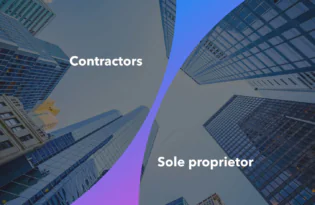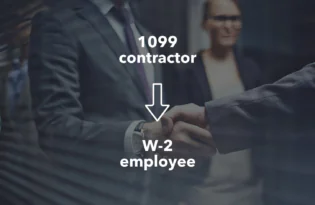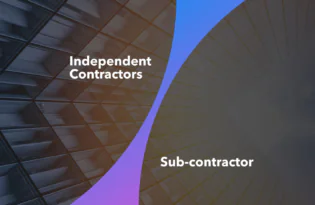How to hire independent contractors
Unsure of how to hire independent contractors? Our team made this handy guide for business owners looking to expand their teams.

For business owners expanding their operations internationally, the question of how to hire independent contractors is especially tricky; for that reason, our team created this checklist to help business owners when hiring independent contractors.
Before you get started, however, you’ll need to determine whether or not the worker actually qualifies as an independent contractor.
For a more in-depth exploration of how to tell, consult our IRS 20-point checklist. The most important considerations are summarized below:
- Who controls where, when, and how the work is performed?
- Who, if anyone, trains the worker?
- Can the worker make a profit or incur a loss from the role?
- How is the worker paid?
- Who, if anyone, provides the worker with the tools to perform the job?
Once you have determined that the worker does qualify as an independent contractor, follow the steps below:
How to hire independent contractors, step-by-step
The process of hiring independent contractors can vary depending on a few special factors discussed in the sections below (e.g., country of hire, company policy, industry-specific qualifications), but the process generally works like this:
Hiring an independent contractor, step-by-step
The sections below detail each of these steps, providing additional market information where applicable to help business owners navigate the process for themselves.
1. Determine your budget
Pricing for an independent contractor varies depending on the individual; level of experience, industry standards, and even the role itself affect their likely asking price. The most common plans for paying a freelancer are either:
- Hourly, in which the business owner pays a certain dollar amount per hour worked, with time logged by the freelancer
- Project-based, in which a total amount for a specific project — a landing page or a logo, for example — is paid before or after the project’s completion.
How much these rates actually end up being depends a great deal on the requisite experience of the contractor, as well as the unique role they will play in your company.
That being said, we’ve provided a few averages for common freelance positions in the table below:
Hiring an independent contractor: Average pay by skill level
| Role | Level | Hourly | Project-based |
|---|---|---|---|
| Graphic designer(Basic logo design) | Entry level | $20-$40 | ~$200 |
| Mid-level | $40-$65 | ~$400 | |
| Senior | $65+ | ~$900 | |
| Copywriter(1,000-word blog post) | Entry level | $25-$50 | ~$110 |
| Mid-level | $50-$75 | ~$325 | |
| Senior | $75+ | ~$650 | |
| Web developer(Build a basic landing page) | Entry level | $40-$60 | ~$1,000 |
| Mid-level | $60-$100 | ~$2,000 | |
| Senior | $100+ | ~$4,000 | |
| Virtual assistant(Manage an inbox/calendar for a week) | Entry level | $8-$15 | ~$200 |
| Mid-level | $15-$25 | ~$500 | |
| Senior | $25+ | ~$850 |
These figures are assumed in a general sense; actual numbers may vary based on the contractor.
Project-based payments are also sometimes administered over time in milestones, in which a certain percentage of the total payment is given as the contractor passes agreed-upon events in the project. This might look something like the following:
Milestone payment example: Blog/Article
| Milestone # | Milestone 1 | Milestone 2 | Milestone 3 | Milestone 4 |
|---|---|---|---|---|
| Description | The freelancer/contractor provides an outline that is approved by the client | The freelancer/contractor turns in their first draft of the piece | The freelancer/contractor meets with the client to discuss edits | The freelancer/contractor completes the agreed-upon edits, and the piece is published |
| % total payment | 20% | 20% | 20% | 20% |
Another common payment method when hiring a 1099 contractor is to keep them on retainer for ongoing projects. Freelancers have their own rates for this, as well, depending on both experience and role being discussed:
Average contractor retainer fees by experience level and profession
| Role | Level | Retainer (Monthly) |
|---|---|---|
| Graphic Designer | Entry Level | ~$550 |
| Mid-Level | ~$850 | |
| Senior | ~$1,750 | |
| Copywriter | Entry Level | ~$650 |
| Mid-Level | ~$1,250 | |
| Senior | ~$2,100 | |
| Web Developer | Entry Level | ~$1,000 |
| Mid-Level | ~$1,750 | |
| Senior | ~$3,250 | |
| Virtual Assistant | Entry Level | ~$500 |
| Mid-Level | ~$900 | |
| Senior | ~$1,400 |
These figures are indicative and may vary depending on the contractor’s experience, location, and scope of work.
Because there are so many factors involved in hiring an independent contractor, it can be challenging to know which of these options makes the most sense for your budget. You should consult a specialist if you are unsure, but the following rules of thumb can be beneficial:
- Hourly wages are best for basic freelance work due to their inherent flexibility, ensuring that business owners lose less money when there is no work to be done.
- Project-based wages work best for clients looking for short-term work with a defined end and a deadline to meet it.
- Retainer wages are best for clients with a substantial budget and a heavy amount of ongoing work that will require persistent attention.
Once you’ve determined the scope of your work and set the correct budget, the next step is to ensure that you are hiring an independent contractor who is capable of performing the job.
2. Vet applicants
Vetting an applicant is about more than just evaluating their expertise; it also requires a great deal of paperwork to ensure that they are even eligible to work for you.
How to hire contractors: The vetting process
| Step | Description |
|---|---|
| Identity Verification | The business owner needs to confirm the legal name of the applicant, which can be done with a valid copy of a state ID or passport, as provided by the contractor. |
| The business owner needs to check the contractor’s business registration with the relevant regulatory authority. This is typically either: The Secretary of State’s office for LLCs Local government websites for DBAs The applicant should have numbers for one of these or an employer identification number (EIN) for tax purposes. | |
| In the event that they are hiring internationally, they will also need to confirm the applicant’s passport and work/visa according to local regulations. | |
| Tax Form Collection | Applicants need either a W-9 if they are applying domestically within the United States. If they are applying internationally, they will require a W-88EN for accurate tax reporting. |
| Background Check | Business owners will need to choose a reputable provider to conduct a background check on the applicant. These services MUST be compliant with Fair Credit Reporting Act (FCRA) standards. |
| Classification Assessment | The business owner must ensure that the applicant is officially listed as a contractor under federal law. Check our IRS 20-point checklist if you are unsure of this classification. |
This process requires wading through a great deal of red tape, so it’s a good idea to conduct this and the next two steps of hiring an independent contractor with an experienced legal professional or relegating this work to an experienced agent of record (AOR) platform.
Once the company has officially made the call to hire the freelancer, the next step is to create their employment contract.
3. Draft a locally compliant contract
A contract agreement for an independent contractor requires a few essential pieces of information. Above all else, it must include:
- The contractor’s name, contact information, and country of residence
- The scope of work being done, including intended start/end dates, with work itemized where applicable/necessary
- The agreed-upon rate of pay and any relevant administration dates/milestones
- The agreed-upon payment method and currency, if applicable
- Employment status, specifying that the worker is a contractor and not an employee
- Who owns the intellectual property of the finished work
- Any confidentiality statements or NDA clauses relevant to the contractor’s interaction with the company
- A clear delineation of how and when each party can exit the agreement
- Which country’s laws (the company’s or the contractors) apply in a dispute
- Who is responsible for tax filings and insurance
It might be tempting to work from scratch, but often, it’s much easier to work from an existing template and ideate according to the needs of the contract. You will, however, need to have your legal team adapt the contract for your company and develop some personalized boilerplate for future contracts.
Your contract, however, will need to be compliant with local labor laws. This is true both when hiring U.S. contractors (individual states have their own labor laws affecting freelance contracts) and internationally, where laws at the federal/regional level have a significant impact on their hiring practices.
4. Onboard the contractor
Once the contract is signed and returned, the final step in the process is to onboard the contractor. While many see this stage as getting the contractor acquainted with the office and their new role in it, onboarding typically involves a great deal of HR work to:
- Set up payment
- Set up the invoice process
- Approve security & access clearance
- Confirm preferred communication channels
This process is done within the company’s internal documentation system, making uniform advice challenging to provide.
Our best advice is to document everything, while mitigating misclassification errors before they occur is preferable, having the necessary paperwork in the event of an audit may save the company thousands of dollars in fines.
How can I make hiring independent contractors easier?
Hiring an independent contractor is a complex process, typically requiring a full-time staff of trained specialists to ensure that your 1099 contractors stay that way in the eyes of the law.
Circumstances like these may warrant additional coverage, such as that provided by an agent of record (AOR) platform. These service providers partner with businesses to handle the heavy lifting of hiring independent contractors, helping your new workers stay compliant with local labor laws and managing the tasks associated with facilitating their contract.
Hiring independent contractors
| Self-managed | With AOR | |
|---|---|---|
| Onboarding | Manual setup w/varied contracts | AOR provides localized onboarding services |
| Classification | Owner collects/files tax forms, assuming all the risk themselves | AOR assumes classification responsibilities and risk |
| Payments | Owner manages FX, transfers, currency conversion manually | AOR-provided tools handle local currency payments on behalf of the owner |
| Compliance | Owner is responsible for adhering to local labor laws | AOR ensures local compliance, including locally compliant contracts |
| Invoicing | Owner is responsible for managing invoices on their own | Contractor portal provides clear payment status |
Do I need an Agent of record (AOR) to hire independent contractors?
There are a few reasons why a business owner might want to hire through an AOR platform rather than hire an independent contractor on their own:
- Scalability: The goal of most business owners is to grow their operations over time. AOR platforms provide leaders looking for scalable options with the ability to easily expand or shrink those operations according to need with managed services.
- International Hiring: One of the central benefits of an AOR is that it offers support to handle compliance related to worker classification as per local labor laws.
- Concerns over misclassification: Companies requiring in-depth work sustained over a long time may prefer to work with an AOR since it manages a significant portion of their business relationship with the contractor over time.
- Operating on a lean staff: Smaller companies without the resources of an in-house legal team to check compliance and handle onboarding/payments typically choose to outsource those tasks to an AOR to help manage their budget.
Still wondering how to hire independent contractors?
Even if you’ve hired 1099 contractors in the past, the reality is that hiring an independent contractor is difficult. Misclassification is a significant risk, especially in areas where the nature of employment is a bit more gray than others, and that can result in massive fines, which affect your bottom line.
AOR platforms provide one of the best possible options for business owners looking to stay compliant and maintain KYC standards. If you are unsure of how to proceed, consider a free demo of Payoneer Workforce Management’s AOR platform to see how it might help your operations.
FAQs
1. How do I protect myself when hiring an independent contractor?
Use a written contract that clearly defines the scope of work, payment terms, deadlines, and ownership of work. Verify their legal status to work, collect the correct tax forms (like a W-9 or W-8BEN), and avoid controlling how they do their job to maintain proper classification.
2. What are the IRS rules for 1099 workers?
The IRS considers someone a 1099 worker if they are self-employed and control how, when, and where they work. Employers must not provide benefits or direct supervision. You must report payments of $600 or more using Form 1099-NEC.
3. What should I consider when hiring a 1099 contractor?
Check their qualifications, confirm they meet legal classification standards, and be sure your contract covers scope, deliverables, payment terms, and intellectual property rights. Also, consider whether they have their own tools, set their own hours, and serve multiple clients.
Related resources
Latest articles
-
Planning to hire employees in Portugal? Here’s a quick guide
Looking to hire employees in Portugal for your U.S. company? Learn about employment in Portugal and how Payoneer Workforce Management helps you hire in Portugal.
-
Planning to hire employees in Italy? Here’s a quick guide
Want to hire employees in Italy? Discover the most common hiring methods, legal requirements, and employer responsibilities of U.S. companies hiring in Italy.
-
Planning to hire employees in China? Here’s a quick guide
Are you looking to hire employees in China? Learn about employment in China and how Payoneer WFM can help American companies hiring in China.
-
Planning to hire employees in Mexico? Here’s a quick guide
Are you looking to hire employees in Mexico? Learn how to hire a team in Mexico and how Payoneer Workforce Management can help U.S. companies hiring in Mexico.
-
Planning to hire employees in Malaysia? Here’s a quick guide
Are you looking to hire employees in Malaysia? Learn about hiring in Malaysia and how Payoneer Workforce Management can help American companies hiring in Malaysia.
-
Optimizing your financial website for AI-powered search algorithms
SWIFT connects 11,000+ banks worldwide, powering secure international transfers. This guide explains how SWIFT works, why it’s still widely used, how to find your SWIFT code, and how Payoneer helps you receive global payments efficiently.
Disclaimer
The information in this article/on this page is intended for marketing and informational purposes only and does not constitute legal, financial, tax, or professional advice in any context. Payoneer and Payoneer Workforce Management are not liable for the accuracy, completeness or reliability of the information provided herein. Any opinions expressed are those of the individual author and may not reflect the views of Payoneer or Payoneer Workforce Management. All representations and warranties regarding the information presented are disclaimed. The information in this article/on this page reflects the details available at the time of publication. For the most up-to-date information, please consult a Payoneer and/or Payoneer Workforce Management representative or account executive.
Availability of cards and other products is subject to customer’s eligibility. Not all products are available in all jurisdictions in the same manner. Nothing herein should be understood as solicitation outside the jurisdiction where Payoneer Inc. or its affiliates is licensed to engage in payment services, unless permitted by applicable laws. Depending on or your eligibility, you may be offered the Corporate Purchasing Mastercard, issued by First Century Bank, N.A., under a license by Mastercard® and provided to you by Payoneer Inc., or the Payoneer Business Premium Debit Mastercard®, issued and provided from Ireland by Payoneer Europe Limited under a license by Mastercard®.
Skuad Pte Limited (a Payoneer group company) and its affiliates & subsidiaries provide EoR, AoR, and contractor management services.















